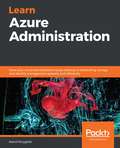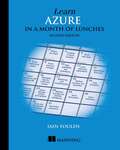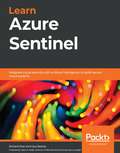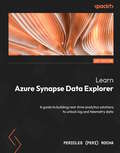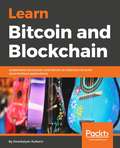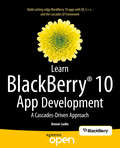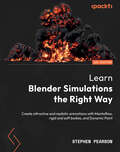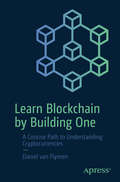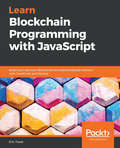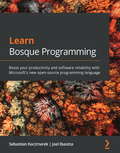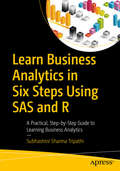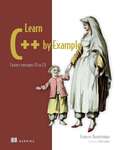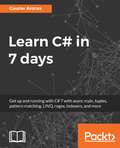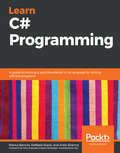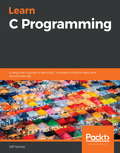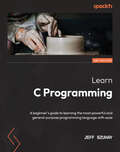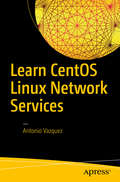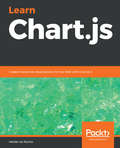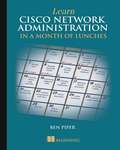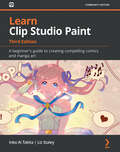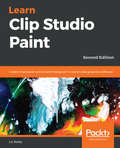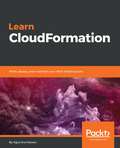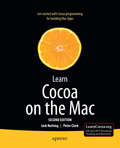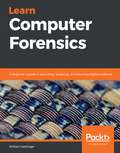- Table View
- List View
Learn Azure Administration: Solve your cloud administration issues relating to networking, storage, and identity management speedily and efficiently
by Kamil MrzyglodEnhance your Azure administration and Azure DevOps skills and get up and running with networking, security, automation, and effective cost managementKey FeaturesExplore a variety of administration patterns used for different cloud architecturesDiscover best practices for administering various IT systems hosted in AzureAdminister, automate, and manage your Azure cloud environment effectivelyBook DescriptionMicrosoft Azure is one of the upcoming cloud platforms that provide cost-effective solutions and services to help businesses overcome complex infrastructure-related challenges. This book will help you scale your cloud administration skills with Microsoft Azure.Learn Azure Administration starts with an introduction to the management of Azure subscriptions, and then takes you through Azure resource management. Next, you'll configure and manage virtual networks and find out how to integrate them with a set of Azure services. You'll then handle the identity and security for users with the help of Azure Active Directory, and manage access from a single place using policies and defined roles. As you advance, you'll get to grips with receipts to manage a virtual machine. The next set of chapters will teach you how to solve advanced problems such as DDoS protection, load balancing, and networking for containers. You'll also learn how to set up file servers, along with managing and storing backups. Later, you'll review monitoring solutions and backup plans for a host of services. The last set of chapters will help you to integrate different services with Azure Event Grid, Azure Automation, and Azure Logic Apps, and teach you how to manage Azure DevOps.By the end of this Azure book, you'll be proficient enough to easily administer your Azure-based cloud environment.What you will learnExplore different Azure services and understand the correlation between themSecure and integrate different Azure componentsWork with a variety of identity and access management (IAM) modelsFind out how to set up monitoring and logging solutionsBuild a complete skill set of Azure administration activities with Azure DevOpsDiscover efficient scaling patterns for small and large workloadsWho this book is forThis book is for cloud administrators, system administrators, and IT professionals who want to scale up their skillset and enter the world of cloud computing. IT professionals and engineers who are already familiar with the basics of the Azure services and are looking for a step-by-step guide to solving the most common Azure problems will also find this book useful. Basic understanding of cloud concepts such as IaaS, PaaS, virtualization, networking, and common Azure services is required.
Learn Azure in a Month of Lunches
by Iain FouldsLearn Azure in a Month of Lunches, Second Edition, is a tutorial on writing, deploying, and running applications in Azure. In it, you&’ll work through 21 short lessons that give you real-world experience. Each lesson includes a hands-on lab so you can try out and lock in your new skills.Summary You can be incredibly productive with Azure without mastering every feature, function, and service. Learn Azure in a Month of Lunches, Second Edition gets you up and running quickly, teaching you the most important concepts and tasks in 21 practical bite-sized lessons. As you explore the examples, exercises, and labs, you'll pick up valuable skills immediately and take your first steps to Azure mastery! This fully revised new edition covers core changes to the Azure UI, new Azure features, Azure containers, and the upgraded Azure Kubernetes Service. Purchase of the print book includes a free eBook in PDF, Kindle, and ePub formats from Manning Publications. About the technology Microsoft Azure is vast and powerful, offering virtual servers, application templates, and prebuilt services for everything from data storage to AI. To navigate it all, you need a trustworthy guide. In this book, Microsoft engineer and Azure trainer Iain Foulds focuses on core skills for creating cloud-based applications. About the book Learn Azure in a Month of Lunches, Second Edition, is a tutorial on writing, deploying, and running applications in Azure. In it, you&’ll work through 21 short lessons that give you real-world experience. Each lesson includes a hands-on lab so you can try out and lock in your new skills. What's inside Understanding Azure beyond point-and-click Securing applications and data Automating your environment Azure services for machine learning, containers, and more About the reader This book is for readers who can write and deploy simple web or client/server applications. About the author Iain Foulds is an engineer and senior content developer with Microsoft. Table of Contents PART 1 - AZURE CORE SERVICES 1 Before you begin 2 Creating a virtual machine 3 Azure Web Apps 4 Introduction to Azure Storage 5 Azure Networking basics PART 2 - HIGH AVAILABILITY AND SCALE 6 Azure Resource Manager 7 High availability and redundancy 8 Load-balancing applications 9 Applications that scale 10 Global databases with Cosmos DB 11 Managing network traffic and routing 12 Monitoring and troubleshooting PART 3 - SECURE BY DEFAULT 13 Backup, recovery, and replication 14 Data encryption 15 Securing information with Azure Key Vault 16 Azure Security Center and updates PART 4 - THE COOL STUFF 17 Machine learning and artificial intelligence 18 Azure Automation 19 Azure containers 20 Azure and the Internet of Things 21 Serverless computing
Learn Azure Sentinel: Integrate Azure security with artificial intelligence to build secure cloud systems
by Richard Diver Gary Bushey Jason S. RaderUnderstand how to set up, configure, and use Azure Sentinel to provide security incident and event management services for your environment Key Features Secure your network, infrastructure, data, and applications on Microsoft Azure effectively Integrate artificial intelligence, threat analysis, and automation for optimal security solutions Investigate possible security breaches and gather forensic evidence to prevent modern cyber threats Book Description Azure Sentinel is a Security Information and Event Management (SIEM) tool developed by Microsoft to integrate cloud security and artificial intelligence (AI). Azure Sentinel not only helps clients identify security issues in their environment, but also uses automation to help resolve these issues. With this book, you'll implement Azure Sentinel and understand how it can help find security incidents in your environment with integrated artificial intelligence, threat analysis, and built-in and community-driven logic. This book starts with an introduction to Azure Sentinel and Log Analytics. You'll get to grips with data collection and management, before learning how to create effective Azure Sentinel queries to detect anomalous behaviors and patterns of activity. As you make progress, you'll understand how to develop solutions that automate the responses required to handle security incidents. Finally, you'll grasp the latest developments in security, discover techniques to enhance your cloud security architecture, and explore how you can contribute to the security community. By the end of this book, you'll have learned how to implement Azure Sentinel to fit your needs and be able to protect your environment from cyber threats and other security issues. What you will learn Understand how to design and build a security operations center Discover the key components of a cloud security architecture Manage and investigate Azure Sentinel incidents Use playbooks to automate incident responses Understand how to set up Azure Monitor Log Analytics and Azure Sentinel Ingest data into Azure Sentinel from the cloud and on-premises devices Perform threat hunting in Azure Sentinel Who this book is for This book is for solution architects and system administrators who are responsible for implementing new solutions in their infrastructure. Security analysts who need to monitor and provide immediate security solutions or threat hunters looking to learn how to use Azure Sentinel to investigate possible security breaches and gather forensic evidence will also benefit from this book. Prior experience with cloud security, particularly Azure, is necessary.
Learn Azure Synapse Data Explorer: A guide to building real-time analytics solutions to unlock log and telemetry data
by Pericles (Peri) RochaA hands-on guide to working on use cases helping you ingest, analyze, and serve insightful data from IoT as well as telemetry data sources using Azure Synapse Data ExplorerFree PDF included with this bookKey FeaturesAugment advanced analytics projects with your IoT and application dataExpand your existing Azure Synapse environments with unstructured dataBuild industry-level projects on integration, experimentation, and dashboarding with Azure SynapseBook DescriptionLarge volumes of data are generated daily from applications, websites, IoT devices, and other free-text, semi-structured data sources. Azure Synapse Data Explorer helps you collect, store, and analyze such data, and work with other analytical engines, such as Apache Spark, to develop advanced data science projects and maximize the value you extract from data.This book offers a comprehensive view of Azure Synapse Data Explorer, exploring not only the core scenarios of Data Explorer but also how it integrates within Azure Synapse. From data ingestion to data visualization and advanced analytics, you'll learn to take an end-to-end approach to maximize the value of unstructured data and drive powerful insights using data science capabilities. With real-world usage scenarios, you'll discover how to identify key projects where Azure Synapse Data Explorer can help you achieve your business goals. Throughout the chapters, you'll also find out how to manage big data as part of a software as a service (SaaS) platform, as well as tune, secure, and serve data to end users.By the end of this book, you'll have mastered the big data life cycle and you'll be able to implement advanced analytical scenarios from raw telemetry and log data.What you will learnIntegrate Data Explorer pools with all other Azure Synapse servicesCreate Data Explorer pools with Azure Synapse Studio and Azure PortalIngest, analyze, and serve data to users using Azure Synapse pipelinesIntegrate Power BI and visualize data with Synapse StudioConfigure Azure Machine Learning integration in Azure SynapseManage cost and troubleshoot Data Explorer pools in Synapse AnalyticsSecure Synapse workspaces and grant access to Data Explorer poolsWho this book is forIf you are a data engineer, data analyst, or business analyst working with unstructured data and looking to learn how to maximize the value of such data, this book is for you. If you already have experience working with Azure Synapse and want to incorporate unstructured data into your data science project, you'll also find plenty of useful information in this book. To maximize your learning experience, familiarity with data and performing simple queries using SQL or KQL is recommended. Basic knowledge of Python will help you get more from the examples.
Learn Bitcoin and Blockchain: Understanding blockchain and Bitcoin architecture to build decentralized applications
by Kirankalyan KulkarniGet up and running with the fundamentals of Bitcoin and blockchainKey FeaturesLearn quick, effective, and easy ways to master blockchain and Bitcoin Understand the impact of decentralization and discover ways to tackle it Explore the future of Bitcoin and blockchain and implement them in a business networkBook DescriptionBlockchain is a distributed database that enables permanent, transparent, and secure storage of data. Blockchain technology uses cryptography to keep data secure. Learn Bitcoin and Blockchain is the perfect entry point to the world of decentralized databases.This book will take you on a journey through the blockchain database, followed by advanced implementations of the blockchain concept. You will learn about Bitcoin basics and their technical operations. As you make your way through the book, you will gain insight into this leading technology and its implementation in the real world. You will also cover the technical foundation of blockchain and understand the fundamentals of cryptography and how they keep data secure. In the concluding chapters, you’ll get to grips with the mechanisms behind cryptocurrencies.By the end of this book, you will have learned about decentralized digital money, advanced blockchain concepts, and Bitcoin and blockchain security.What you will learnUnderstand the concept of decentralization, its impact, its relationship with blockchain technology and its pros and consLearn blockchain and Bitcoin architectures and securityExplore Bitcoin and blockchain securityImplement blockchain technology and its features commerciallyUnderstand why consensus protocols are critical in blockchainGet a grip on the future of blockchainWho this book is forLearn Bitcoin and Blockchain is for anyone who wants to quickly understand and expand their knowledge of how blockchain and Bitcoin work and how they are applied commercially. No prior knowledge of blockchain and Bitcoin is required.
Learn BlackBerry 10 App Development: A Cascades-Driven Approach
by Anwar LudinLearn how to leverage the BlackBerry 10 Cascades framework to create rich native applications. Learn BlackBerry 10 App Development gives you a solid foundation for creating BlackBerry 10 apps efficiently. Along the way, you will learn how to use QML and JavaScript for designing your app's UI, and C++/Qt for the application logic. No prior knowledge of C++ is assumed and the book covers the fundamental aspects of the language for writing BlackBerry 10 apps. Also a particular emphasis is put on how to create a visually enticing user experience with the Cascades framework, which is based on Qt and QML. Starting with the native SDK configuration and an overview of the Momentics IDE, the book is fast-paced and you will rapidly learn many of the best practices and techniques required for developing beautiful BlackBerry 10 apps. Learn BlackBerry 10 App Development is written for developers wishing to learn how to write apps for the new BlackBerry 10 OS and those interested in porting existing iOS and Android apps to BlackBerry 10 as native applications. What you'll learn * How to design and create native BB10 applications using the declarative expressiveness of QML * How to master the Cascades framework and the core BB10 UI components * How to use C++ and Qt efficiently with Cascades * How to utilize the BlackBerry Momentics IDE to launch and debug your applications * How to apply the fundamental aspects and best practices of BB10 application design * How to use HTTP networking in order to leverage remote services * How to integrate your application with BlackBerry 10 core apps such as the Contacts and Calendar apps * How to send email and short text messages from your app * How to use your device's camera and sensors such as the accelerometer and gyroscope Who this book is for BlackBerry developers wishing to write native BB10 applications, game developers. iOS and Android developers wishing to port their apps to BB 10. Table of Contents Getting Started QML & JavaScript C++, Qt and Cascades Controls Application Structure ListView and DataModel HTTP Networking Personal Information Management APIs Sensors Invocation Framework Device File System
Learn Blender Simulations the Right Way: Create attractive and realistic animations with Mantaflow, rigid and soft bodies, and Dynamic Paint
by Stephen PearsonAn in-depth guide to using the power of Mantaflow, rigid body, soft body, cloth simulations, and Dynamic Paint in Blender 3.3 to create campfires, waterfalls, explosions, flags, and much moreKey FeaturesUnderstand Mantaflow to create fire and smoke simulationsLearn to design satisfying animations using soft bodies and the cloth simulationConstruct realistic physics animations with rigid bodiesBook DescriptionBlender is a free, open source 3D software that allows you to create stunning visual graphics, animation, VFX, and much more!This book is an in-depth guide to creating realistic and eye-catching simulations, understanding the various settings and options around their creation, and learning how to troubleshoot solutions to your own Blender problems. In addition, this book can also be used to simulate the behavior of certain physics effects, such as fire, fluid, soft bodies, and rigid bodies.You'll learn how to use Mantaflow, an open source framework within Blender software, to create fire, smoke, and fluid simulations. As you progress, you'll understand how to easily produce satisfying rigid and soft body simulations, along with cloth simulations. Finally, you'll use Dynamic Paint, Blender's modifier, and the physics system to create eye-catching animations.By the end of this Blender book, you'll have created a number of animations on your own, such as a campfire, waterfalls, and explosions. You'll also have gained a deeper understanding of all the simulation options in Blender, which you can use to create portfolio-ready animations.What you will learnDiscover what Mantaflow is and how to use it effectivelyUnderstand domains, flows, and effectors, and why they are importantCreate realistic fire, smoke, and fluid simulationsProduce satisfying soft and rigid body simulations with easeUse the cloth simulation to bring animated fabric to lifeExplore canvas and brush objects in Dynamic Paint to create eye-catching animationsWho this book is forIf you're a VFX artist, 3D artist, game designer, or any Blender user who wants to learn about Mantaflow and physics simulations, then this book is for you. You're expected to have basic knowledge of the Blender interface and how to use it.
Learn Blockchain by Building One: A Concise Path to Understanding Cryptocurrencies
by Daniel van FlymenAs crytpocurrencies and their underlying data structure, blockchains, become further intertwined in our daily lives, a full understanding of them is essential to anyone who wants to keep up and remain informed of the future of finance. There is no better learning method than a hands-on one, and Learn Blockchain by Building One offers just that.Develop your own blockchain using Python with step-by-step instructions from author Daniel van Flyman, an expert in the field. You will come away with a confident working knowledge of popular cryptocurrencies such as Bitcoin and Ethereum and which foundations make them work. Through helpful exercises and real-world examples, you will understand the core concepts of peer-to-peer networking, Proof of Work, hashing, encryption, and digital signatures.Learn Blockchain by Building One gives you timely, real-world lessons in blockchain and cryptocurrencies that you will need as our modern society becomes increasingly digitally sophisticated. The lasting implications of such technology, such as the security of personal transactions and the role of government regulation, are not to be underestimated. Stay ahead of the curve and become a confident blockchain builder now!What You Will LearnDevelop a fully-fledged blockchain in PythonObtain a ground-up understanding of of Proof of WorkGrasp core cryptographic concepts, such as hashing, encryption, and digital signaturesUnderstand how gossip protocols and peer-to-peer networking works by implementing a TCP client-serverRealize the differences and trade-offs between popular blockchains such as Bitcoin and Ethereum Who This Book Is For This book is aimed at intermediate programmers in any area from finance to academia. Readers should be comfortable reading and writing basic Python.
Learn Blockchain Programming with JavaScript: Build your very own Blockchain and decentralized network with JavaScript and Node.js
by Eric TraubLearn Blockchain Programming with JavaScript is for JavaScript developers who wish to learn about blockchain programming or build their own blockchain using JavaScript frameworks.
Learn Bosque Programming: Boost your productivity and software reliability with Microsoft's new open-source programming language
by Sebastian Kaczmarek Joel IbacetaDiscover the benefits of regularized programming by implementing Bosque to build a variety of reliable appsKey FeaturesGet up and running with the Bosque programming language and use it to build better softwareStreamline your app development and improve productivity using Bosque programmingEliminate sources of complexity such as loops, recursion, and invariants to develop quality productsBook DescriptionBosque is a new high-level programming language inspired by the impact of structured programming in the 1970s. It adopts the TypeScript syntax and ML semantics and is designed for writing code that is easy to reason about for humans and machines. With this book, you'll understand how Bosque supports high productivity and cloud-first development by removing sources of accidental complexity and introducing novel features. This short book covers all the language features that you need to know to work with Bosque programming. You'll learn about basic data types, variables, functions, operators, statements, and expressions in Bosque and become familiar with advanced features such as typed strings, bulk algebraic data operations, namespace declarations, and concept and entity declarations. This Bosque book provides a complete language reference for learning to program with Bosque and understanding the regularized programming paradigm. You'll also explore real-world examples that will help you to reinforce the knowledge you've acquired. Additionally, you'll discover more advanced topics such as the Bosque project structure and contributing to the project. By the end of this book, you'll have learned how to configure the Bosque environment and build better and reliable software with this exciting new open-source language.What you will learnFind out what the Bosque project isIdentify accidental complexity in code and how to overcome it with BosqueUnderstand the principles of the regularized programming paradigmInstall and configure the Bosque environmentGet hands-on experience using the Bosque language and its key featuresRecognize the advantages of explicit code intermediate representation designWho this book is forThis book is for experienced developers and early adopters who are interested in learning a new, mindset-changing programming language. You'll also find this book useful if you know TypeScript or JavaScript programming and want to understand the advantages of Bosque compared to other programming languages. Experience with any programming language and knowledge of various programming paradigms such as structured programming and functional programming are required to get started with this book.
Learn Business Analytics in Six Steps Using SAS and R
by Subhashini Sharma TripathiApply analytics to business problems using two very popular software tools, SAS and R. No matter your industry, this book will provide you with the knowledge and insights you and your business partners need to make better decisions faster. Learn Business Analytics in Six Steps Using SAS and R teaches you how to solve problems and execute projects through the "DCOVA and I" (Define, Collect, Organize, Visualize, Analyze, and Insights) process. You no longer need to choose between the two most popular software tools. This book puts the best of both worlds—SAS and R—at your fingertips to solve a myriad of problems, whether relating to data science, finance, web usage, product development, or any other business discipline.What You'll LearnUse the DCOVA and I process: Define, Collect, Organize, Visualize, Analyze and Insights. Harness both SAS and R, the star analytics technologies in the industry Use various tools to solve significant business challengesUnderstand how the tools relate to business analytics See seven case studies for hands-on practiceWho This Book Is ForThis book is for all IT professionals, especially data analysts, as well as anyone whoLikes to solve business problems and is good with logical thinking and numbers Wants to enter the analytics world and is looking for a structured book to reach that goalIs currently working on SAS , R, or any other analytics software and strives to use its full power
Learn C++ by Example: Covers versions 11 to 23 (Bookcamp Ser.)
by Frances BuontempoLearn the latest features of modern C++ by coding eight engaging projects.Don&’t let the multitude of C++ updates intimidate you! Learn C++ by Example takes you through the major language changes since C++ 11, with each new feature demonstrated with a fun project or minigame. It&’s perfect for beginners who know C++ basics, coders coming back to the language, or current C++ developers missing out on everything the language has to offer. Inside Learn C++ by Example you&’ll find important skills such as: Utilizing the new C++ features from C++ 11 to 23 Effectively testing your C++ code What happens &“under the hood&” of C++ code Picking efficient algorithms and data structures std::format, STL algorithms, ranges, and coroutines Learn C++ by Example rapidly gets up to speed with C++&’s updates and changes, and ensures you&’ll stay ahead as the language continues to change and grow. You&’ll learn about vectors and ranges by generating Pascal&’s triangle, create a racing game with new special member functions, build a slot machine with parameter packs, and more. Foreword by Matt Godbolt. About the technology C++ delivers the flexibility and performance you need for everything from low-level systems programming to secure financial applications and AAA game development. First introduced in 1985, the language is still evolving, with exciting changes in every new version. Whether you&’re just getting started or you&’re a veteran coder adding to your toolbox, the eight hands-on projects in this book will get you up to speed on modern C++ features and practices. About the book Learn C++ by Example is a fun and practical way to start writing modern C++ code. It guides you through entertaining challenges, emphasizing features and techniques made possible by C++ 17, 20, and 23. You&’ll learn about objects and arrays by creating a deck of playing cards, master the C++ random library for a number guess game, use the chrono library to create a countdown timer, and much more. Along the way you&’ll also pick up valuable tips for testing, project organization, and other productivity skills. What's inside New C++ features from C++ 11 to 23 Effectively test your C++ code What happens &“under the hood&” Efficient algorithms and data structures About the reader Requires beginner to intermediate C++ skills. About the author Frances Buontempo is an experienced C++ developer and the editor of ACCU&’s Overload magazine. The technical editor on this book was Timothy Jaap van Deurzen. Table of Contents 1 Hello again, C++! 2 Containers, iterators, and ranges 3 Input of strings and numbers 4 Time points, duration, and literals 5 Creating and using objects and arrays 6 Smart pointers and polymorphism 7 Associative containers and files 8 Unordered maps and coroutines 9 Parameter packs and std::visit
Learn C# in 7 days
by Gaurav AroraaLearn C# in 7 days with practical examples, build a foundation for C# programming, and boost your skills to an advanced level About This Book • Learn the basics of C# in 7 days • Works as a reference guide describing the major features of C# • Build easy and simple code through real-world example scenarios Who This Book Is For The book is for aspiring developers and absolute novices who want to get started with the world of programming. You do not need any knowledge of C# for this book. What You Will Learn • Understand and set up the .NET environment • Code in C# using the Visual Studio 2017 RC (preferable community edition) IDE • Define variables, syntax, control flows, statements, and arrays etc through examples • Understand the concepts of Object-Oriented Programming using C# • Get acquainted with attributes, collection, generics, and LINQ • Get your hands on class members such as Modifiers, Methods, Properties, Indexers, File I/O, Exception Handling, and Regex • Build a real-world application using C# 7 In Detail This book takes a unique approach to teach C# to absolute beginners. You'll learn the basics of the language in seven days. It takes a practical approach to explain the important concepts that build the foundation of the C# programming language. The book begins by teaching you the basic fundamentals using real-world practical examples and gets you acquainted with C# programming. We cover some important features and nuances of the language in a hands-on way, helping you grasp the concepts in a fluid manner. Later, you'll explore the concepts of Object-Oriented Programming (OOP) through a real-world example. Then we dive into advanced-level concepts such as generics and collections, and you'll get acquainted with objects and LINQ. Towards the end, you'll build an application that covers all the concepts explained in the book. By the end of this book, you will have next-level skills and a good knowledge of the fundamentals of C#. Style and approach Fast paced guide to get you up-to-speed with the language. Every chapter is followed by an exercise that focuses on building something with the language. The codes of the exercises can be found on the Packt website
Learn C# Programming: A guide to building a solid foundation in C# language for writing efficient programs
by Marius Bancila Raffaele Rialdi Ankit Sharma Dino EspositoGet started with C# and strengthen your knowledge of core programming concepts such as procedural, object-oriented, generic, functional, and asynchronous programming along with the latest features of C# 8 Key Features Learn the fundamentals of C# with the help of easy-to-follow examples and explanations Leverage the latest features of C# 8, including nullable reference types, pattern matching enhancements, and asynchronous streams Explore object-oriented programming, functional programming, and multithreading concepts Book Description The C# programming language is often developers' primary choice for creating a wide range of applications for desktop, cloud, and mobile. In nearly two decades of its existence, C# has evolved from a general-purpose, object-oriented language to a multi-paradigm language with impressive features. This book will take you through C# from the ground up in a step-by-step manner. You'll start with the building blocks of C#, which include basic data types, variables, strings, arrays, operators, control statements, and loops. Once comfortable with the basics, you'll then progress to learning object-oriented programming concepts such as classes and structures, objects, interfaces, and abstraction. Generics, functional programming, dynamic, and asynchronous programming are covered in detail. This book also takes you through regular expressions, reflection, memory management, pattern matching, exceptions, and many other advanced topics. As you advance, you'll explore the .NET Core 3 framework and learn how to use the dotnet command-line interface (CLI), consume NuGet packages, develop for Linux, and migrate apps built with .NET Framework. Finally, you'll understand how to run unit tests with the Microsoft unit testing frameworks available in Visual Studio. By the end of this book, you'll be well-versed with the essentials of the C# language and be ready to start creating apps with it. What you will learn Get to grips with all the new features of C# 8 Discover how to use attributes and reflection to build extendable applications Utilize LINQ to uniformly query various sources of data Use files and streams and serialize data to JSON and XML Write asynchronous code with the async-await pattern Employ .NET Core tools to create, compile, and publish your applications Create unit tests with Visual Studio and the Microsoft unit testing frameworks Who this book is for If you have little experience in coding or C# and want to learn the essentials of C# programming to develop powerful programming techniques, this book is for you. It will also help aspiring programmers to write scripts or programs to accomplish specific tasks.
Learn C Programming: A beginner's guide to learning C programming the easy and disciplined way
by Jeff SzuhayGet started with writing simple programs in C while learning the skills that will help you work with practically any programming language Key Features Learn essential C concepts such as variables, data structures, functions, loops, and pointers Get to grips with the core programming aspects that form the base of many modern programming languages Explore the expressiveness and versatility of the C language with the help of sample programs Book Description C is a powerful general-purpose programming language that is excellent for beginners to learn. This book will introduce you to computer programming and software development using C. If you're an experienced developer, this book will help you to become familiar with the C programming language. This C programming book takes you through basic programming concepts and shows you how to implement them in C. Throughout the book, you'll create and run programs that make use of one or more C concepts, such as program structure with functions, data types, and conditional statements. You'll also see how to use looping and iteration, arrays, pointers, and strings. As you make progress, you'll cover code documentation, testing and validation methods, basic input/output, and how to write complete programs in C. By the end of the book, you'll have developed basic programming skills in C, that you can apply to other programming languages and will develop a solid foundation for you to advance as a programmer. What you will learn Understand fundamental programming concepts and implement them in C Write working programs with an emphasis on code indentation and readability Break existing programs intentionally and learn how to debug code Adopt good coding practices and develop a clean coding style Explore general programming concepts that are applicable to more advanced projects Discover how you can use building blocks to make more complex and interesting programs Use C Standard Library functions and understand why doing this is desirable Who this book is for This book is written for two very diverse audiences. If you're an absolute beginner who only has basic familiarity with operating a computer, this book will help you learn the most fundamental concepts and practices you need to know to become a successful C programmer. If you're an experienced programmer, you'll find the full range of C syntax as well as common C idioms. You can skim through the explanations and focus primarily on the source code provided.
Learn C Programming: A beginner's guide to learning the most powerful and general-purpose programming language with ease, 2nd Edition
by Jeff SzuhayGet started with writing simple programs in C while learning core programming conceptsKey FeaturesLearn essential C concepts such as variables, data structures, functions, loops, and pointersGrasp the core programming aspects that form the base of many modern programming languagesWork with updated code samples and cover array declaration and initialization in detail in this new editionBook DescriptionThe foundation for many modern programming languages such as C++, C#, JavaScript, and Go, C is widely used as a system programming language as well as for embedded systems and high-performance computing. With this book, you'll be able to get up to speed with C in no time.The book takes you through basic programming concepts and shows you how to implement them in the C programming language. Throughout the book, you'll create and run programs that demonstrate essential C concepts, such as program structure with functions, control structures such as loops and conditional statements, and complex data structures. As you make progress, you'll get to grips with in-code documentation, testing, and validation methods. This new edition expands upon the use of enumerations, arrays, and additional C features, and provides two working programs based on the code used in the book. What's more, this book uses the method of intentional failure, where you'll develop a working program and then purposely break it to see what happens, thereby learning how to recognize possible mistakes when they happen.By the end of this C programming book, you'll have developed basic programming skills in C that can be easily applied to other programming languages and have gained a solid foundation for you to build on as a programmer.What you will learnImplement fundamental programming concepts through C programsUnderstand the importance of creating complex data types and the functions to manipulate themDevelop good coding practices and learn to write clean codeValidate your programs before developing them furtherUse the C Standard Library functions and understand why it is advantageousBuild and run a multi-file program with MakeGet an overview of how C has changed since its introduction and where it is goingWho this book is forIf you're an absolute beginner who has basic familiarity with operating a computer, this book will help you learn the most fundamental concepts and practices that you need to know to become a successful C programmer. If you're an experienced programmer, you'll find the full range of C syntax as well as common C idioms covered in the book useful.
Learn C Programming: A beginner's guide to learning the most powerful and general-purpose programming language with ease
by Jeff SzuhayGet started with writing simple programs in C while learning core programming conceptsKey FeaturesLearn essential C concepts such as variables, data structures, functions, loops, and pointersGrasp the core programming aspects that form the base of many modern programming languagesWork with updated code samples and cover array declaration and initialization in detail in this new editionBook DescriptionThe foundation for many modern programming languages such as C++, C#, JavaScript, and Go, C is widely used as a system programming language as well as for embedded systems and high-performance computing. With this book, you'll be able to get up to speed with C in no time. The book takes you through basic programming concepts and shows you how to implement them in the C programming language. Throughout the book, you’ll create and run programs that demonstrate essential C concepts, such as program structure with functions, control structures such as loops and conditional statements, and complex data structures. As you make progress, you’ll get to grips with in-code documentation, testing, and validation methods. This new edition expands upon the use of enumerations, arrays, and additional C features, and provides two working programs based on the code used in the book. What's more, this book uses the method of intentional failure, where you'll develop a working program and then purposely break it to see what happens, thereby learning how to recognize possible mistakes when they happen. By the end of this C programming book, you’ll have developed basic programming skills in C that can be easily applied to other programming languages and have gained a solid foundation for you to build on as a programmer.What you will learnImplement fundamental programming concepts through C programsUnderstand the importance of creating complex data types and the functions to manipulate themDevelop good coding practices and learn to write clean codeValidate your programs before developing them furtherUse the C Standard Library functions and understand why it is advantageousBuild and run a multi-file program with MakeGet an overview of how C has changed since its introduction and where it is goingWho this book is forIf you're an absolute beginner who has basic familiarity with operating a computer, this book will help you learn the most fundamental concepts and practices that you need to know to become a successful C programmer. If you're an experienced programmer, you'll find the full range of C syntax as well as common C idioms covered in the book useful.
Learn CentOS Linux Network Services
by Antonio VazquezLearn to set up the latest CentOS Linux network services including DNS, DHCP, SSH and VNC, Web, FTP, Mail, Firewall, and LDAP, enabling you to provide these services on your own network. CentOS continues to be a popular Linux distribution choice, and setting up your own services is a key skill for anyone maintaining a CentOS network. You will learn how to install CentOS, and manage basic administration. You'll then move onto understanding networking, and how to set up your required services. Each chapter is written in an easy-to-digest format and teaches you how set up, manage, and troubleshoot each service. You'll be running your own network in no time at all. What You Will Learn Install and set up the latest version of CentOS Configure and manage a wide range of network services Solve problems remotely and manage your network efficiently Who This Book Is For Anyone who wants to learn how to set up and manage CentOS Linux network services. Some previous Linux experience is beneficial, but this book is designed to be used by beginners.
Learn Chart.js: Create interactive visualizations for the Web with Chart.js 2
by Helder da RochaDesign interactive graphics and visuals for your data-driven applications using the popular open-source Chart.js data visualization library.Key FeaturesHarness the power of JavaScript, HTML, and CSS to create interactive visualizationsDisplay quantitative information efficiently in the form of attractive charts by using Chart.js A practical guide for creating data-driven applications using open-source JavaScript libraryBook DescriptionChart.js is a free, open-source data visualization library, maintained by an active community of developers in GitHub, where it rates as the second most popular data visualization library. If you want to quickly create responsive Web-based data visualizations for the Web, Chart.js is a great choice.This book guides the reader through dozens of practical examples, complete with code you can run and modify as you wish. It is a practical hands-on introduction to Chart.js. If you have basic knowledge of HTML, CSS and JavaScript you can learn to create beautiful interactive Web Canvas-based visualizations for your data using Chart.js. This book will help you set up Chart.js in a Web page and show how to create each one of the eight Chart.js chart types. You will also learn how to configure most properties that override Chart’s default styles and behaviors. Practical applications of Chart.js are exemplified using real data files obtained from public data portals. You will learn how to load, parse, filter and select the data you wish to display from those files. You will also learn how to create visualizations that reveal patterns in the data. This book is based on Chart.js version 2.7.3 and ES2015 JavaScript.By the end of the book, you will be able to create beautiful, efficient and interactive data visualizations for the Web using Chart.js.What you will learnLearn how to create interactive and responsive data visualizations using Chart.jsLearn how to create Canvas-based graphics without Canvas programmingCreate composite charts and configure animated data updates and transitionsEfficiently display quantitative information using bar and line charts, scatterplots, and pie chartsLearn how to load, parse, and filter external files in JSON and CSV formatsUnderstand the benefits of using a data visualization frameworkWho this book is forThe ideal target audience of this book includes web developers and designers, data journalists, data scientists and artists who wish to create interactive data visualizations for the Web. Basic knowledge of HTML, CSS, and JavaScript is required. No Canvas knowledge is necessary.
Learn Cisco Network Administration in a Month of Lunches
by Ben PiperSummaryLearn Cisco Network Administration in a Month of Lunches is a tutorial designed for beginners who want to learn how to administer Cisco switches and routers. Just set aside one hour a day (lunchtime would be perfect) for a month, and you'll start learning practical Cisco Network administration skills faster than you ever thought possible.Purchase of the print book includes a free eBook in PDF, Kindle, and ePub formats from Manning Publications.About the TechnologyCisco's ultrareliable routers and switches are the backbone of millions of networks, but "set and forget" is not an acceptable attitude. Fortunately, you don't have to be an old-time administrator to set up and maintain a Cisco-based network. With a handful of techniques, a little practice, and this book, you can keep your system in top shape.About the BookLearn Cisco Network Administration in a Month of Lunches is designed for occasional and full-time network administrators using Cisco hardware. In 22 bite-sized lessons, you'll learn practical techniques for setting up a Cisco network and making sure that it never fails. Real-world labs start with configuring your first switch and guide you through essential commands, protocols, dynamic routing tricks, and more. What's InsideUnderstand your Cisco network, including the difference between routers and switchesConfigure VLANs and VLAN trunksSecure your networkConnect and configure routers and switchesEstablish good maintenance habitsAbout the ReaderThis book is written for readers with no previous experience with Cisco networking. About the AuthorBen Piper is an IT consultant who holds numerous Cisco, Citrix, and Microsoft certifications including the Cisco CCNA and CCNP. He has created many video courses on networking, Cisco CCNP certification, Puppet, and Windows Server Administration.Table of ContentsBefore you beginWhat is a Cisco network?A crash course on Cisco's Internetwork Operating SystemManaging switch portsSecuring ports by using the Port Security featureManaging virtual LANs (VLANs)Breaking the VLAN barrier by using switched virtual interfacesIP address assignment by using Dynamic Host Configuration ProtocolSecuring the network by using IP access control listsConnecting switches using trunk linksAutomatically configuring VLANs using the VLAN Trunking ProtocolProtecting against bridging loops by using the Spanning Tree ProtocolOptimizing network performance by using port channelsMaking the network scalable by connecting routers and switches togetherManually directing traffic using the IP routing tableA dynamic routing protocols crash courseTracking down devicesSecuring Cisco devicesFacilitating troubleshooting using logging and debuggingRecovering from disasterPerformance and health checklistNext steps
Learn Clip Studio Paint: A beginner's guide to creating compelling comics and manga art, 3rd Edition
by Inko Ai Takita Liz StaleyDiscover the tools to tell your own manga story with Clip Studio Paint and develop your digital drawing skillsKey FeaturesA helpful guide to gain a clear understanding of Clip Studio Paint and create your own manga stories with key images printed in colorLearn to put CSP into practice by implementing it in real-world drawing scenariosDiscover how to apply digital drawing techniques to your creation using CSPBook DescriptionClip Studio Paint is a versatile digital painting program for creating manga and illustrations, helping artists expand their digital portfolio. This software is packed with tools that make panel laying, speech adding, toning, and editing much easier. This easy-to-follow guide is clearly divided into chapters covering drawing tools, interface customization, and using various visual effects so you can focus on specific techniques in detail one at a time.Learn Clip Studio Paint is a comprehensive introduction for those who are new to Clip Studio Paint that will have you up to speed in no time. You'll start by experiencing what it's like to create manga digitally and find new ways to shape your drawing. Next, using practical tips and rich visual references, the book shows you how to apply techniques to your creations, giving you the opportunity to expand your range of visual expression. As you advance, you'll explore how to create special effect brushes using an in-depth example, along with discovering how to color, blend, and edit your art digitally. Finally, you'll find out how to print, use the Clip Studio Paint Assets, and learn how to create unique and inspiring art that stands out from the rest.By the end of this Clip Studio Paint book, you'll have gained a clear understanding of its tools and be able to start telling your own manga story using your improved digital drawing skills.What you will learnExplore Clip Studio Paint and create your own manga storiesFamiliarize yourself with the CSP ecosystemUse Clip Studio Paint Pro's inking tools and find ways to customize your artExplore the flexibility of the brush engine in Clip Studio Paint ProUse palettes to generate colors between foreground and background colorsFind out alternative ways of coloring your manga art using black, white, and greyDiscover how to use layer blending to add textures to your imagesWho this book is forIf you're just starting out as a digital artist or want to switch to Clip Studio Paint from a different graphics software package, then this book is for you. Those with no prior knowledge of digital art or intermediate-level users looking to explore the unique features of Clip Studio Paint will also find this book useful.
Learn Clip Studio Paint - Second Edition: Create Impressive Comics And Manga Art In World-class Graphics Software, 2nd Edition
by Liz StaleyIf you are a beginning digital artist or are switching to Clip Studio from another graphics software, this book is for you. This book is excellent for those with no knowledge of digital art up to intermediate users looking to explore the unique features of Clip Studio Paint.
Learn CloudFormation: Write, deploy, and maintain your AWS infrastructure
by Agus KurniawanGet up and running with AWS automation using CloudFormationKey FeaturesExplore the fundamentals of AWS CloudFormationGet acquainted with concepts such as CloudFormation templates and mappingsLearn to implement Infrastructure as a Code (IaC) on AWSBook DescriptionAs the Amazon Web Services (AWS) infrastructure is gradually moving towards cloud, managing cloud-related tasks efficiently continues to be a challenge for system administrators. CloudFormation is a language developed for managing infrastructure-related services efficiently on AWS and its features help secure the AWS resource deployment process.Learn CloudFormation serves as a fundamental guide to kick-start your journey on CloudFormation. We will introduce you to the basic concepts on IaC and the AWS services required for implementing automation and infrastructure management. Then, we deep dive into concepts such as CloudFormation mapping, conditions, limit, and output and EC2. In the concluding chapters, you will manage the entire AWS infrastructure using CloudFormation templates.By the end of this book, you will get up and running with IaC with CloudFormation.What you will learnUnderstand AWS CloudFormationDevelop AWS CloudFormation templatesDeploy AWS CloudFormation for AWS resourcesBuild your first AWS CloudFormation projectExplore AWS Security featuresDeploy testing and production stages using CloudFormationWho this book is forLearn CloudFormation is for cloud engineers, system administrators, cloud architects, or any stakeholders working in the field of cloud development or cloud administration. Basic knowledge of AWS is necessary.
Learn Cocoa on the Mac
by Jack Nutting Peter ClarkThe Cocoa frameworks are some of the most powerful for creating native OS X apps available today. However, for a first-time Mac developer, just firing up Xcode 4 and starting to browse the documentation can be a daunting and frustrating task. The Objective-C class reference documentation alone would fill thousands of printed pages, not to mention all the other tutorials and guides included with Xcode. Where do you start? Which classes are you going to need to use? How do you use Xcode and the rest of the tools? Learn Cocoa for the Mac, Second Edition, completely revised for OS X Mountain Lion and XCode 4, answers these questions and more, helping you find your way through the jungle of classes, tools, and new concepts so that you can get started on the next great OS X app today. Jack Nutting and Peter Clark are your guides through this forest; Jack and Peter have lived here for years, and will show you which boulder to push, which vine to chop, and which stream to float across in order to make it through. You will learn not only how to use the components of this rich framework, but also which of them fit together, and why. Jack Nutting's approach, combining pragmatic problem-solving with a deep respect for the underlying design philosophies contained within Cocoa, stems from years of experience using these frameworks. Peter Clark will show you which parts of your app require you to jump in and code a solution, and which parts are best served by letting Cocoa take you where it wants you to go. The path over what looks like a mountain of components and APIs has never been more thoroughly prepared for your travels. In each chapter, you'll build an app that explores one or more areas of the Cocoa landscape. With Jack's and Peter's guidance, the steep learning curve becomes a pleasurable adventure. There is still much work for the uninitiated, but by the time you're done, you will be well on your way to becoming a Cocoa master.
Learn Computer Forensics: A beginner's guide to searching, analyzing, and securing digital evidence
by William OettingerGet up and running with collecting evidence using forensics best practices to present your findings in judicial or administrative proceedings Key Features Learn the core techniques of computer forensics to acquire and secure digital evidence skillfully Conduct a digital forensic examination and document the digital evidence collected Analyze security systems and overcome complex challenges with a variety of forensic investigations Book Description A computer forensics investigator must possess a variety of skills, including the ability to answer legal questions, gather and document evidence, and prepare for an investigation. This book will help you get up and running with using digital forensic tools and techniques to investigate cybercrimes successfully. Starting with an overview of forensics and all the open source and commercial tools needed to get the job done, you'll learn core forensic practices for searching databases and analyzing data over networks, personal devices, and web applications. You'll then learn how to acquire valuable information from different places, such as filesystems, e-mails, browser histories, and search queries, and capture data remotely. As you advance, this book will guide you through implementing forensic techniques on multiple platforms, such as Windows, Linux, and macOS, to demonstrate how to recover valuable information as evidence. Finally, you'll get to grips with presenting your findings efficiently in judicial or administrative proceedings. By the end of this book, you'll have developed a clear understanding of how to acquire, analyze, and present digital evidence like a proficient computer forensics investigator. What you will learn Understand investigative processes, the rules of evidence, and ethical guidelines Recognize and document different types of computer hardware Understand the boot process covering BIOS, UEFI, and the boot sequence Validate forensic hardware and software Discover the locations of common Windows artifacts Document your findings using technically correct terminology Who this book is for If you're an IT beginner, student, or an investigator in the public or private sector this book is for you.This book will also help professionals and investigators who are new to incident response and digital forensics and interested in making a career in the cybersecurity domain.
